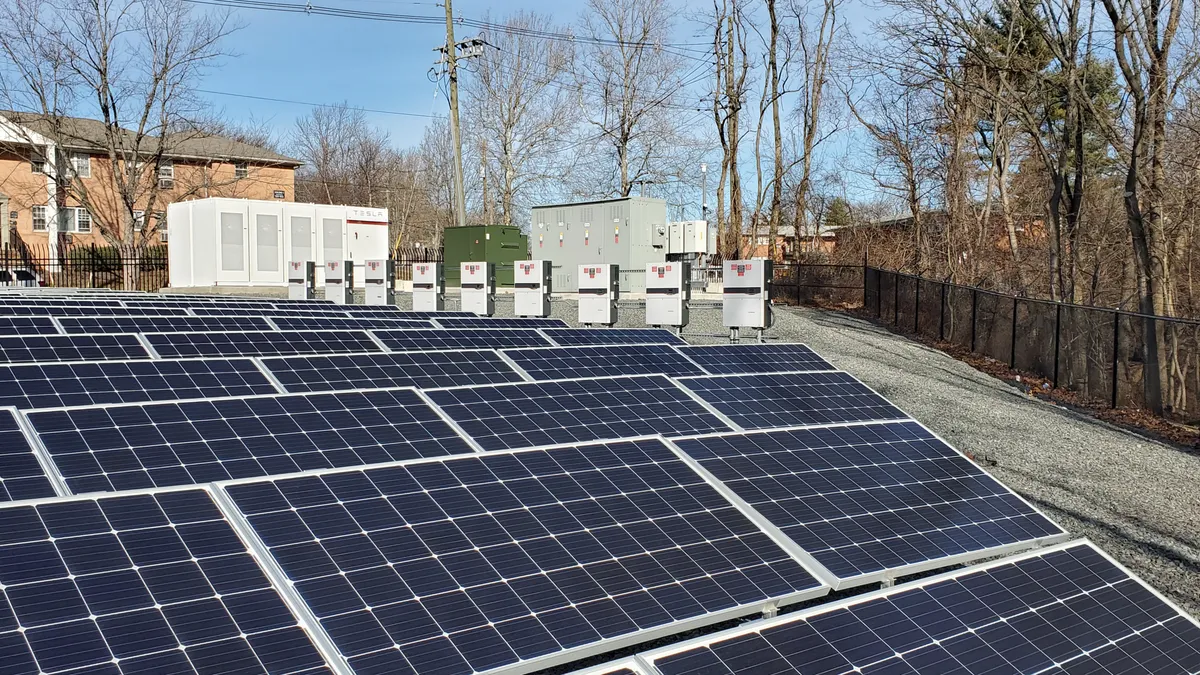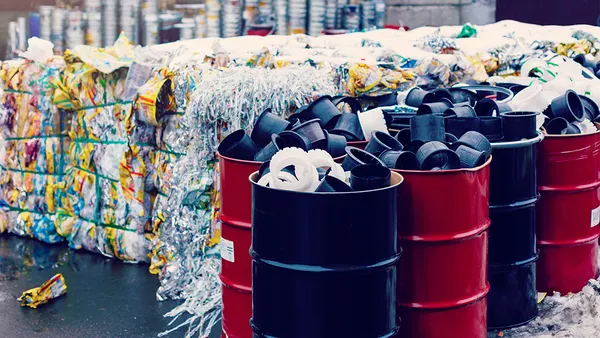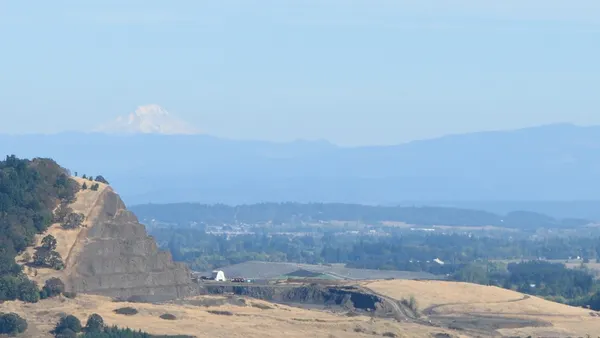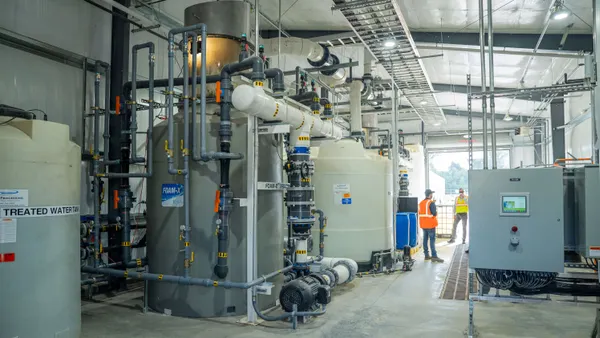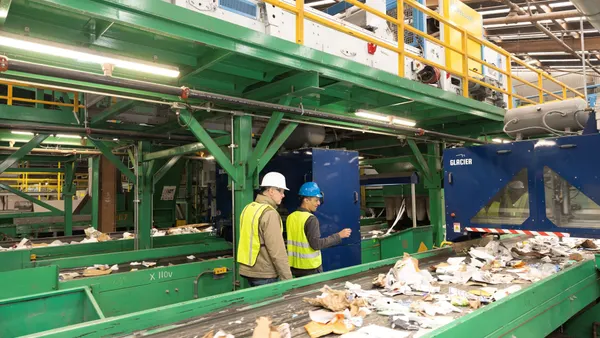Solar panel installations have been one of the fastest-growing types of energy infrastructure in recent years and landfills have become fitting sites due to the sheer amount of land required. Now, for many of the same reasons, energy project developers are looking to landfills for a technology growing even faster than solar: battery storage.
Storage on landfills is still a novel idea, with closed sites seen as largely the most suitable, and only a few examples of these projects exist. But solar on landfills was in a similar position just a few years ago, Tim Ryan, director at New York-based developer BQ Energy, told Waste Dive. BQ Energy focuses specifically on brownfield sites and has built over a dozen solar or wind projects since 2012, but only recently began construction on its first storage venture. Solar on landfills “may seem routine now, but it wasn’t when we started," Ryan said.
States like California, New York and Massachusetts have embraced aggressive goals for reducing carbon emissions, requiring a quick transition to renewable energy as the primary source of electricity over the next several decades. That shift will require storage, such as large lithium-ion batteries, to compensate for the intermittency of wind and solar. Batteries can charge up from solar panels when the sun is shining, and then dispatch that energy at other times – at night or on cloudy days – when the panels are not producing energy.
New energy storage capacity in the U.S. grew from 311 megawatts (MW) deployed in 2018 to 523 MW deployed in 2020, compared to utility-scale solar that grew from around 6,000 MW added in 2018 to around 8,000 MW in 2020, according to Wood Mackenzie. The research firm expects storage deployments to be 14 times larger by 2025, exponentially more than the growth rate for utility-scale solar.
Acres of potential
The states moving the fastest towards more renewable energy backed by storage are also those where land development is relatively difficult, due to factors like population density and environmental restrictions. The answer, according to Strategic Management Group CEO Kelly Sarber, is to tap the large footprint of landfills.
Sarber, a veteran developer of numerous waste-related sites, said she currently has seven projects in various stages of development to build battery storage at landfills and wastewater treatment facilities. Under this model, the landfill owner receives a lease payment with some profit share for providing a 2-10 acre site to locate the energy storage project with access to the grid.
While she is bound by non-disclosure agreements regarding the specific identity of her partners, Sarber said some projects are in California and New York. The interest has been mostly word of mouth so far, driven not only by state-level policies that create a market for storage capacity, but also by clean energy goals at the municipal level. Battery storage lets those cities take credit for more clean energy that offsets their emissions, and also can cut the costs of operating landfills that serve those cities, or turn a closed landfill from a liability to an asset.
“Typically there is just empty space at these facilities that are not being used,” Sarber said in an interview.
She is also targeting sites that use landfill gas to generate electricity. The batteries can use the interconnection to the electric grid, freeing up the gas to be used for other purposes like being sold as vehicle fuel. “So there is the opportunity to create two revenue streams instead of just one,” Sarber said.
Despite this potential, there are only a few examples of storage projects located on landfills to date. “It is still a nascent technology. Waste companies operate in a different silo from energy storage,” Sarber said.
Landfill development also has its own set of challenges with various permitting and regulatory costs and those can be heightened when a technology is not fully familiar or established. For solar projects, the costs have been partially defrayed by tax credits and other incentives, according to Jesse Grossman, CEO of renewable energy project developer Soltage. Some states, like Massachusetts, offer specific assistance to solar developers who want to redevelop brownfield sites.
“As for storage on landfills, we haven't seen specific incentives in place for these types of projects yet. One reason there may not be incentives in place for storage on landfills is that landfills are usually in rural areas with low power demand and batteries are most useful near city centers to mitigate congestion and provide backup power to high power demand areas,” said Grossman.
But some projects have emerged in the past several years, coinciding with certain states implementing the first regulatory storage incentives in the United States.
BQ Energy’s first solar plus storage project is aiming for commercial operation in New York later this year. Located in Westchester County, on the town of Mount Kisco’s closed landfill, the project will consist of solar power at nearly 1 MW of capacity, backed up by a 2-megawatt-hour battery storage system.
The biggest reason BQ Energy has not pursued storage until now is the cost of lithium-ion batteries, “Many of us recognized that energy storage is going to be a part of renewable energy in the future,” said BQ Energy Managing Director Paul Curran. “But it was too expensive.”
That is beginning to change as lithium-ion battery prices have fallen rapidly – Bloomberg New Energy Finance recently estimated prices fell 50% over the past three years and 87% from 2010 to 2019.
Around the same time, New York regulators implemented the Value of Distributed Energy Resources (VDER) tariff, which gives payments to distributed energy sources like solar and battery storage based on the services they provide for the electric grid. VDER created a market incentive to drive BQ Energy to go beyond just a solar project. Because the location was in a “weak spot in the grid” where the local utility needed to improve reliability, the tariff paid extra for a project that addresses that reliability concern, Curran said.
The Mount Kisco development is “our first project" and "it won’t be the last," according to Curran. BQ Energy plans to use the batteries to study the nuances of storage so the company has more confidence to build bigger storage projects in the future.
The project is also receiving a grant to cover part of its capital costs from the New York State Energy Research and Development Authority (NYSERDA). The organization “agrees that brownfields can be attractive sites for solar energy and also energy storage to repurpose these otherwise underutilized sites, especially when these systems are located in close proximity to electric utility distribution system,” a NYSERDA spokesman said in an email. “NYSERDA will continue to monitor opportunities to develop energy storage systems on landfills as the market matures.”
Future growth
Massachusetts-based renewable energy developer Kearsarge Energy has completed dozens of solar projects, but at the beginning of this year, its first solar-plus-storage project came online at a closed landfill in Amesbury, Massachusetts. The developer made this foray due to incentives launched by the state, under which storage installations are treated as an “adder” that increases the rate at which the solar panels are compensated for the electricity they supply to the grid.
“The storage would not have happened without that adder,” said Kearsarge Managing Partner Andrew Bernstein. The business case for solar-plus-storage sited on landfills is not that different than it is for solar by itself sited on landfills, according to Bernstein.
In both cases, there is “virtually nothing else that you can build on the land,” and so a renewable energy project creates an income stream for the site owner from space that would otherwise be dormant. The project provides credits to the city of Amesbury that reduces its energy bills and the electricity generated by the solar panels is also sold into the New England grid.
But the storage component adds yet another revenue stream to the project, while taking up relatively little additional space. Battery storage allows the project to provide services for the grid that wholesale electricity markets need and will pay for beyond the value of the electricity itself. These include tapping the batteries to regulate the frequency of the grid so power lines are not overloaded, and “peak shaving” – discharging the batteries at times of high electricity demand, like the hottest summer days. The merchant income from these services “is just gravy on top” of what the project would otherwise be making from the solar alone, Bernstein said.
Another recently completed solar and storage project was built by Public Service Electric and Gas (PSE&G), the largest utility in New Jersey, on a former landfill owned by the borough of Highland Park. The project, consisting of 1,764 solar panels, uses 2,000- Tesla batteries to reduce voltage fluctuations that can occur for utility-scale solar projects.
“Developing this solar storage project on a closed landfill allowed us to take space that was otherwise unusable and return it to a productive role,” said PSE&G spokesperson Fran Sullivan.
More storage projects, including those on landfills, are possible for PSE&G as New Jersey moves toward new requirements for energy storage. Gov. Phil Murphy has put an emphasis on climate issues in his administration, including a January announcement that the state will aim for 100% clean energy by 2050. One of the steps toward that target is the goal of 600 MW of energy storage by 2021 and 2,000 MW by 2030.
PSE&G had been planning for the need to reduce emissions. In 2018 it announced a “Clean Energy Future” plan for $4.2 billion in investments in various clean energy technologies, including $109 million in energy storage. As part of that plan, the utility has submitted a storage proposal to the New Jersey Board of Public Utilities.
If that proposal is approved, Sullivan said, “there would be a component of our efforts that involve solar storage and, under the right circumstances, it is possible we could use more landfills or brownfields for these projects."


